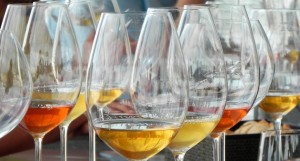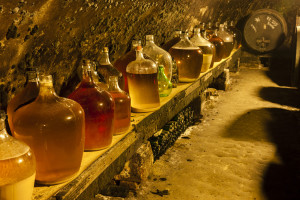Today we have a post from wine educator and author Jim Laughren, CWE. Jim gives us a sneak peak at his session about orange wines, which will be presented as part of SWE’s 41st Annual Conference in August of this year.
Orange, aka amber, aka skin-fermented, aka macerated, aka off-white—white wine made like a red with days, weeks, or months on the skins and stems—is either the new “love-to-hate-‘em” or “dang-that’s-intriguing” or “wow-this-is-really-superb-savory-unexpected” wine kid on the block. Its resurgence began with a gush of “natural” and “non-interventionist” hoopla that was too often shorthand for funky, nasty, BAD tasting wine. Try a dozen, if you could find them, of these nouveau ancient bottlings ten years ago and chances are excellent that at least half of them were, hmmm … questionable, at best.
No matter that orange was likely one of the two original wine colors (the other being red) as folks in the Neolithic were less obsessed with whisking the juice from its skins and stems and producing that star-bright white of which we have become so enamored. Simpler folks, simpler times and all that. Despite all the “advances” in equipment, technique, storage, bottling, and so forth, these ARE wines the ancients would recognize, at least as far as taste is concerned.
Whipsawing our way back to the present, orange winemakers have become more concerned with delicious and drinkable. In fact, it’s now rather easy to find orange wine that has been made in qvevri, amphora, tinaja, wood, concrete and/or stainless steel. Winemakers are plying the better tools of their trade, along with skin contact, to produce a new “generation” of orange wines that are at least alluring, if not downright delectable.
What fruit they offer is more in the peach, pear, apricot, tangerine spectrum. And yet, depending on the specific wine, they are redolent of earth and herbs and tea and seashell and dried flowers and, thanks to their very noticeable tannins (such an organoleptic disconnect: white wine and tannins) coupled with their rich savoriness, orange wines are a nearly perfect food match with almost everything.
So join me, explorers and skeptics alike, and let’s put these autumnal-colored babies to the test. It’s all balderdash until it hits the old olfactory epithelium anyway. A little history, both ancient and recent, a lot of color, and a lovely lineup of orange for your tasting pleasure. Hope to see you in Portland!
Jim’s session, “Orange Wines: How a Collection of Contemporary Winemakers are Putting Some Skin in the Game” will be offered on Thursday, August 10th at 1:00 pm, as part of the Society of Wine Educators’ 41st Annual Conference, to be held in Portland, Oregon.
About the speaker: Jim Laughren, CWE, is committed in his educational endeavors to chop off the highfalutin’ right after the first “i” and present wine and all its glorious permutations in a manner that’s friendly and welcoming to all. He is the author of A Beer Drinker’s Guide To Knowing & Enjoying Fine Wine, named a Kirkus ‘Indie Book of the Year’ in 2013 and has a second volume, 50 Ways To Love Wine More, scheduled for release later this year. Like many of us, he travels frequently to wine regions around the world and enjoys introducing new drinkers to the pleasures of the sacred juice.

